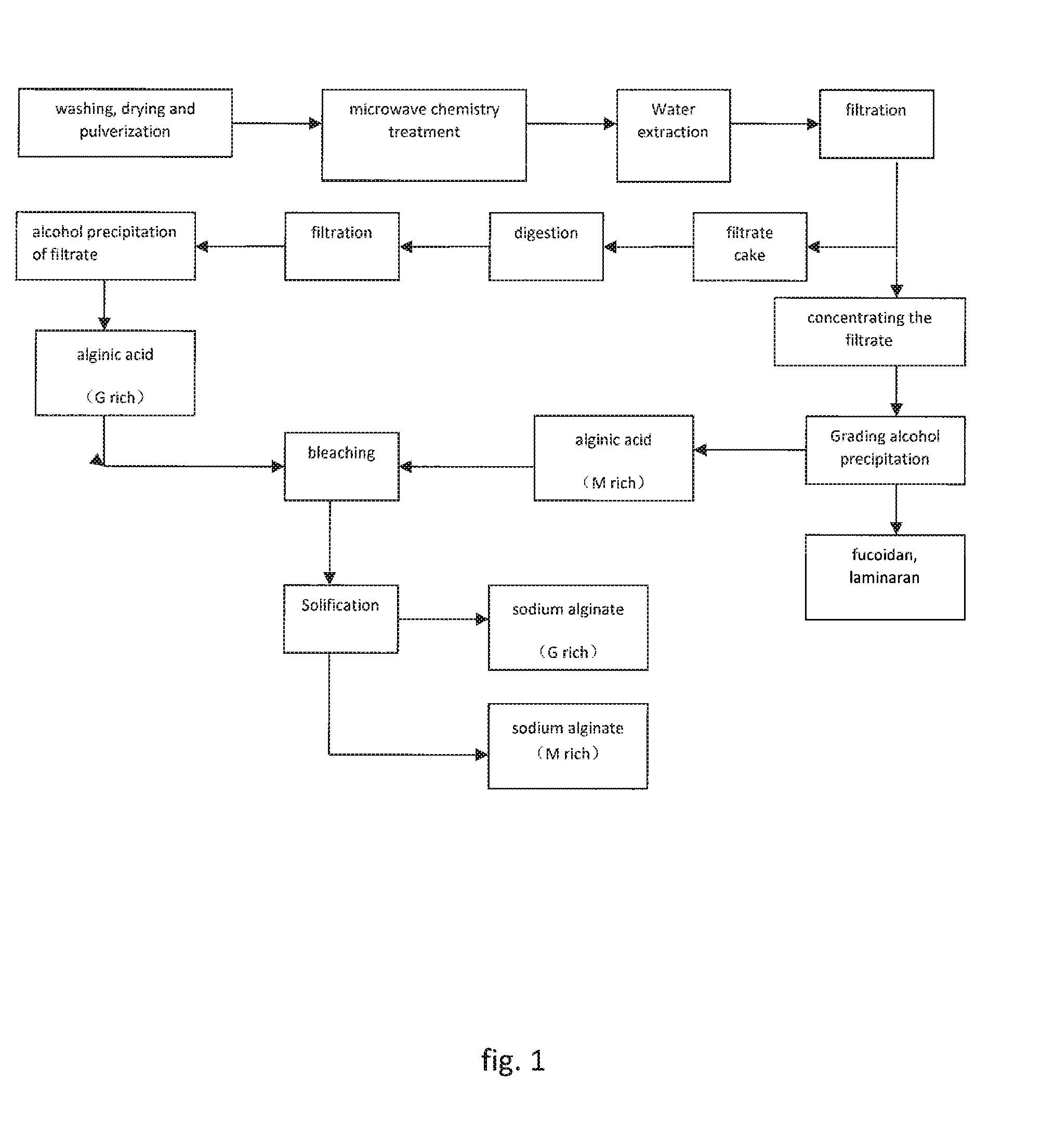Method for extracting brown algae polysaccharide via microwave chemical process
a brown algae and microwave technology, applied in the field of pharmaceutical chemistry, can solve the problems of high water consumption, heavy pollution, heavy water and energy consumption, etc., and achieve the effects of good water solubility, high purity, and reduced water consumption
- Summary
- Abstract
- Description
- Claims
- Application Information
AI Technical Summary
Benefits of technology
Problems solved by technology
Method used
Image
Examples
example 1
[0085]1) 1.5 kg dry japonica powder is placed in a traveling wave microwave reaction chamber;
[0086]2) 0.5 L anhydrous acid and 0.25 L water are mixed to prepare 0.75 L 70% formic acid solution;
[0087]3) 0.75 L formic acid in step 2) is added into the microwave reaction chamber in step 1), and the mixer is sufficiently stirred to evenly wet the japonica powder;
[0088]4) the wetted material in step 3) is subjected to irradiation at 5 KW continuous microwave power until the liquid refluxes, i.e., the organic acid solution is vaporized, and then the microwave is switched to a pulsed microwave power operating mode, wherein the duty ratio is 5 seconds / 5 seconds (i.e. the ratio of on-time and off-time), peak power is 10 KW; after 12 min, vacuuming is conducted (reaction chamber working pressure is 20 mmHg) for reduced pressure distillation until there is no liquid in the microwave reaction chamber; microwave pretreatment of japonica powder is completed;
[0089]5) 5 L absolute ethanol is added ...
example 2
[0095]1) 1.5 kg dry fusiforme powder is placed in a traveling wave microwave reaction chamber;
[0096]2) 180 g oxalic acid and 1.5 L water are mixed to prepare a 10% oxalic acid solution;
[0097]3) 1.5 L oxalic acid solution in step 2) is added into the microwave reaction chamber in step 1), and the mixer is sufficiently stirred to evenly wet the fusiforme powder;
[0098]4) the wetted material in step 3) is subjected to irradiation at 3 KW continuous microwave power until liquid refluxes, i.e., the organic acid solution is vaporized, and then the microwave is switched to a pulsed microwave power operating mode, wherein the duty ratio is 5 seconds / 5 seconds, peak power is 5 KW; after 15 min, vacuuming is conducted (reaction chamber working pressure is 100 mmHg) for reduced pressure distillation to remove the organic acid solution until there is no liquid in the microwave reaction chamber; microwave pretreatment of fusiforme powder is completed;
[0099]5) 5 L absolute ethanol is added into 1....
example 3
[0104]1) 1.5 kg dry kelp powder is placed in a resonant wave microwave reaction chamber;
[0105]2) 0.4 L acetic anhydride and 0.1 L water are mixed to prepare 0.5 L 80% acetic acid solution;
[0106]3) 0.5 L acetic acid solution in step 2) is added into the microwave reaction chamber in step 1), and the mixer is sufficiently stirred to evenly wet the kelp powder;
[0107]4) the wetted material in step 3) is subjected to irradiation at 2 KW continuous microwave power until liquid refluxes, i.e., the organic acid solution is vaporized, and then the microwave is switched to a pulsed microwave power operating mode, wherein the duty ratio is 5 seconds / 5 seconds, peak power is 4 KW; after 35 mins, vacuuming is conducted (reaction chamber working pressure is 200 mmHg) for reduced pressure distillation to remove the organic acid solution until there is no liquid in the microwave reaction chamber;
[0108]5) 5 L absolute ethanol is added into the microwave reaction chamber in step 4), sufficiently stir...
PUM
| Property | Measurement | Unit |
|---|---|---|
| Temperature | aaaaa | aaaaa |
| Temperature | aaaaa | aaaaa |
| Temperature | aaaaa | aaaaa |
Abstract
Description
Claims
Application Information
 Login to View More
Login to View More - R&D
- Intellectual Property
- Life Sciences
- Materials
- Tech Scout
- Unparalleled Data Quality
- Higher Quality Content
- 60% Fewer Hallucinations
Browse by: Latest US Patents, China's latest patents, Technical Efficacy Thesaurus, Application Domain, Technology Topic, Popular Technical Reports.
© 2025 PatSnap. All rights reserved.Legal|Privacy policy|Modern Slavery Act Transparency Statement|Sitemap|About US| Contact US: help@patsnap.com

